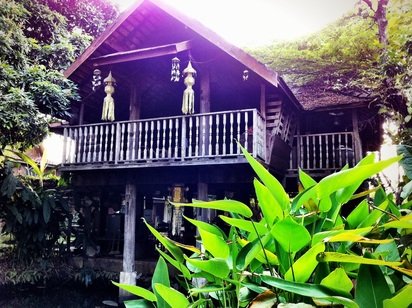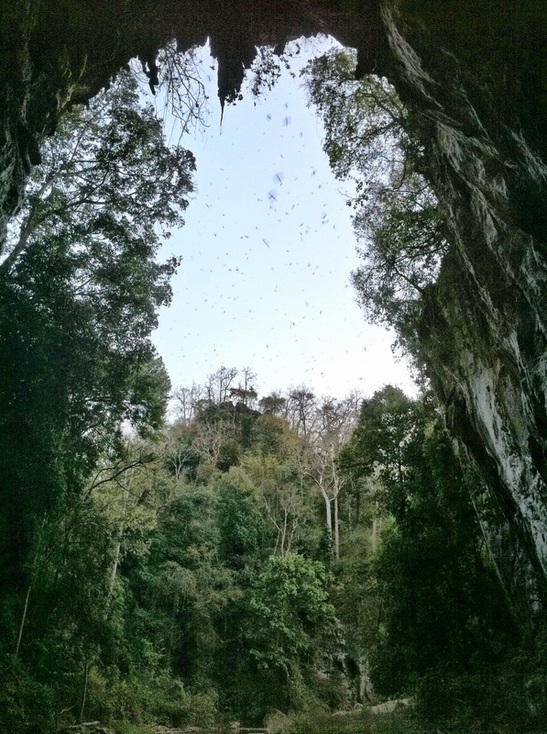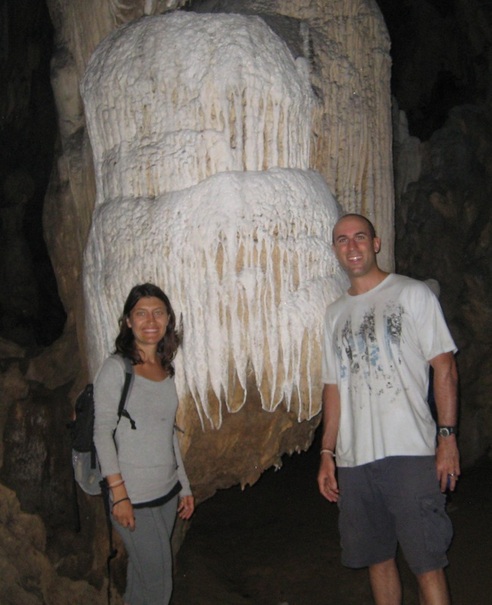After leaving Baan Hom, Neda and I decided to take a day to visit the Elephant Nature Park about 65km outside of Chiang Mai. The founder of the park, Sangduen Chailert (nicknamed “Lek”) has created a sanctuary there for 35 elephants that have been rescued from logging operations, trekking jobs, and landmine accidents. She also cares for elephants whose parents have died, leaving them orphaned with no one to care for them.  Jeff, Neda and Lek, founder of the Elephant Nature Park with Chang Yim, a baby born at the park  A "Family" at the Sanctuary Sanctuaries like this one are increasingly necessary as over the past 100 years the population of elephants in Thailand has plummeted from 100,000 to a mere 3,000. This decline was exacerbated in 1989 when logging was banned in Thailand. Elephants whose main job was dragging cut wood out of forests (which sadly was destroying their own habitat) found themselves out of work and often abandoned. The animals would then search for food and be shot by farmers as nuisances when they encroached upon crops.
Domesticated elephants also suffered because they weren't suited for life in the wild after undergoing the process of Phajaan, or “The Crush”. In this ancient ritual, an elephant is prepared for a life of work through 3-7 days of torture in a wooden cell too small for its body. A whole village participates in the constant prodding and stabbing of an elephant if it shows any resistance to the process. They also throw in sleep, food, and water deprivation for good measure. The local shaman performs black magic to crush the animal's connection to its mother, and thereby its very soul. Some elephants don't even survive the brutal process, and those that do are irreparably traumatized. This trauma is no small thing considering elephant's 80 year lifespan. The Park felt it was important we saw a video of the process of the Phajaan that had been obtained by a journalist, and I agree that it is something everyone should be aware of. I am providing a link here, but please be aware that it is very hard to watch. Click HERE to see it.  A Mahout Feeding his Elephant
The Elephant Nature Park is a special place because it seeks to create new paradigms for our relationships with elephants. Lek believes that domesticated elephants can be trained using positive reinforcement, patience, and love. Each elephant has a mahout (handler) who, instead of using chains and hooks to subdue the animals, uses fruit and baths in the river to reward the elephant for good behavior. The elephants roam freely and create social groups amongst themselves (an amazing feat since they are not related, but are all rescued). Lek and her mahouts' patience seem endless as they lovingly teach and care for their elephants. It is striking how for centuries local people have used only pain and negative reinforcement to train these animals, when a method of love is just as effective and preserves the dignity of the animal.
 Bath time! For us Lek’s approach had broader implications about the way we raise our own children and the ways in which we interact with each other in everyday life. How often do we find ourselves trying to resolve a problem by manipulating someone with fear, pain, triggering their insecurity, etc… It is the ego’s quick solution to getting what it wants and it is incredibly destructive both to the person doing the action and the receiver of it. Lek inspired us to see yet again how a path of love, while sometimes requiring more mindfulness, consistency, and patience, pays off in the long run by preserving the spirit of both parties.
For Neda and me it was a wonderful day. We fed the elephants fresh bananas, melons, and squash. We learned about their personalities and individual stories. We helped bathe them in the park’s river and got elephant kisses for our efforts. They are truly loving, peaceful creatures whose majesty is inspiring to be around. We experienced their intense loyalty to one another and the nurturing and playful spirit that the elephants were able to partly recapture, despite their abuse at the hands of humans. If you’d like to find out more about what you can do to help the plight of the Asian elephant, you can click HERE. Logging is still perfectly legal in Burma so the need for sanctuaries will not stop anytime soon. But if we can remember Lek and her message of love, there may be hope for the elephants as well as for us. Below are a few pics from our day, to see all of the great shots we captures, click here - http://flic.kr/s/aHsjyKDTfQ.  Neda gets an elephant kiss!  Cuddling with Mom  Nothing like a mud bath and taking a load off to cap off a long day!
 A Lotus Flower in the Garden For the past 3 weeks, we have been living in a small village about 10 km outside of Chiang Mai. The property consists of several old style Thai teak homes and luscious gardens filled with medicinal herbs grown by the proprietor, Homprang Chaleekanha. We are learning a special blend of Thai massage techniques, Thai acupressure, and herbal knowledge that our teacher learned growing up with her grandma in a jungle village and that she refined in her doctorate program in Thai Traditional Medicine.
 Our porch! Overlooking a Koi filled pond.  The Sauna before a steam The days go by fast here! We are awakened every morning by the roosters’ crows around 6:30am. After that we do Thai yoga to get the body ready for the day. Thai Yoga is a breath based technique more similar to Tai Chi than vinyasa flow yoga. After a light breakfast we train in Thai Massage for 3 hours. We break for a delicious lunch (Pad Thai, spring rolls, make your own noodle soup, etc…) and continue training until late afternoon. After every day of hard training, we relax our muscles in the custom built herbal steam sauna on the premise. The family uses a blend of herbs they grow in the garden for the sauna. There is Zingiber (an anti-inflammatory root similar to ginger in appearance), Turmeric, Tamarind, tea tree oil, kaffir lime skin, lemon grass, and camphor. It smells wonderful and after cleaning out all the toxins it feels wonderful to dip in the cold pool outside the sauna afterwards. Right after the sauna, all students and guests top the night with a traditional Thai meal and the company of Homprang and her husband Christopher.
We have Saturdays off and we usually head into town for some entertainment. We have met many wonderful people from all over the world here including several from Springfield, MO!!! That was probably the most random coincidence yet! Some of these guys are already planning a trip to Bulgaria to visit us and we are planning several trips to other countries to visit the other friends we have made here!
 Neda, Homprang, and Candace Our teacher Homprang is a truly fascinating person. She grew up in a small village in the Kanchanaburi area of Thailand. There was no electricity, dirt floors in the homes, a limited monetary system (barter was the main economic interaction) and no hospital. To fill that gap, her family acted as traditional medicine doctors that passed the skill on from generation to generation. They used Thai massage and herbs to treat medical problems in the community. Homprang grew up walking on her grandparents to learn Thai Massage and often helped them prepare herbal tonics, teas, and compresses for medicinal purposes. One fascinating technique that Homprang taught us from her grandmother was the ancient practice of “womb lifting”. Nearly every woman in our class had a tilted or prolapsed uterus that caused them pain in everyday life or during their periods. Often overlooked by Western medicine, a displaced uterus can play a major issue in infertility, urinary incontinence, and chronic low back pain. The Western solution is usually some form of surgery, but through this massage and acupressure technique, the body is relaxed and the uterus restored to its proper place. Many women in our class experienced immediate relief – it was amazing to see!
 Preparing to make a heated clay pot surrounded by herbs- used to relax the womb after massage As we have deepened our understanding of Thai massage, we can’t help but notice the similarities of this body work with yoga, meditation, and spiritual growth. As you work with the body, you notice how the breath of the receiver and giver blend and become one. Feeling the muscles relax under your elbow, knee, or thumb, is a release of tension for both. As you move through different positions through the massage, you find yourself in many yoga postures stretching your body as you are helping the person on your mat. In the end, the aim of the practice is not to heal the body, but to make space for the body to heal itself – an activity its been doing quite well for thousands of years.
 Jeff getting his shoulder worked on by the expert This experience has allowed us a very unique glimpse of Thai culture as we have gotten to know Homprang’s family and their history. We are thankful to have gained a deeper knowledge of how to heal our bodies and a deeper understanding of Thai people. A few more days here and then we head North to Laos! In the meantime, if you want to get on the waitlist for some free Thai Massge, make sure to leave us a comment or send us a note! See all the pics of our time at Baan Hom here: http://flic.kr/s/aHsjys6Vs9  A Statue of Shivaga Komarapat - the Buddha's Doctor and "patron saint" of Thai Massage
While we waited for our massage training to start, we headed northeast of Chiang
Mai via nauseatingly windy roads to the small town of Pai. In the early days of
Thai tourism, Pai got a reputation as an ex-pats retreat from the city with a
focus on meditation, spirituality, etc… Once it got popular, however, the center
of this small mountain town transformed into a tourist hub with corresponding
bars and western food restaurants. Still, Pai retains enough of its Thai culture
to stay charming despite its popularity.  Column in Tham Lot Cave While staying in Pai, we took an overnight trip to Soppong (recently re-named Pangmapha) to visit the amazing Tham Lot Cave, which features the largest cave opening in all of SE Asia. Tham Lot is also home to over 300,000 swifts (tiny birds) who return to the cave at sunset every evening in an amazing aerial show. The drive alone was worth the journey - with sweeping views of the countryside and fresh mountain air.
We stayed at a placed called the Cave Lodge, established by an Australian named John and his Thai wife in the early 1980s. It was fascinating to read about John’s life (he wrote a book) about the early days of exploring the numerous caves in the area (Tham Lot Cave is part of one of the largest cave systems in SE Asia). John was exploring Soppong when the opium trade was still in full swing in the area and he survived through the cycles of violence and addiction in the area to establish the Cave Lodge and map out the caves for others to see. At one point he and a crew were underground in a cave for 55 straight hours! They also discovered and began the scientific research on the numerous teak coffins in the area’s caves – remnants of a civilization at least a 1,000 years older than Thai culture.

The Swift show at the exit to Tham Lot Cave - like the Austin Bat Show in reverse!
 Trekking to the cave entrance with our guide We were inspired by the seeming fearlessness that John had displayed in his life as he explored the dark depths of the caves of Soppong. We got our own little taste of working with fear as we took our 125cc motorbike over some steep back country dirt roads riddled with pot holes to visit the small Karen hilltribe village of Ban Huang Paem. We rolled into town and after perusing the hand woven fabrics that the locals brought out and laid on the street, we hired a guide to take us to the Tham Long Yaow Cave. It was an exhilarating and slightly scary feeling to take our tourism into our own hands as we followed this local tribeswoman deep into the jungle to find a cave that the first Westerners visited only 20 or 30 years ago. As we crawled on hands and knees through the narrow entrance trepidation crept up our spines only to be quickly replaced by awe as the cave’s grandeur erupted around us. Beautiful stalagmites and stalactites littered the landscape and “flow rock” (crystalline formations of rock) glistened as our lights fell over it.

Flow Rock at Tham Long Yaow Cave
 Pai Canyon at Sunset Leaving the caves and returning to Pai, we enjoyed a stay at a mountain lodge where we recharged with stunning views of the mountain while practicing yoga, peaceful days reading in hammocks, and fruit carving. We also explored the beautiful Pai Canyon, the area’s steams baths (fed by the Pai Hot Springs) and some waterfalls reachable by motorbike. One day we decided to hike to the Mae Yen waterfall (which is only accessible by foot), a 14km roundtrip trail that is barely marked, leaving us to just “follow the water” as one local told us. We brought 2 liters water and expected the hike to take 3-4 hours roundtrip, but found we didn’t count on the hilly terrain and numerous water crossings. At one point about 3 hours into the hike, we climbed over a rocky outcropping in the water and had trouble finding the trail. Scared about how long the return trip would take and our dwindling water supply, we contemplated returning to town without seeing the falls. We gave ourselves 20 more minutes to try to find the way. At minute 19, as I ducked under a fallen tree, I saw a glimmer of water falling down the mountain side and heard the dull roar of water crashing upon the rocks. We started to run with exhilaration to the clearing where the waterfall gushed. There were no tourists all the way out here in the jungle – just the sound of the water and the beautiful view.

The clearing at the Mae Yen Waterfall
As we hiked back from the falls (the round trip ended up being about 7 hours of hiking), we contemplated how so many of our experiences these past days had almost been derailed by fear. The cave and the hike to the falls seemed an analogy for the spiritual journey. Perhaps each of us must enter our own dark caves to explore, despite the fear it brings up in us. We must somehow find the faith to move into fear and not away from it. At the superficial level it is a belief in our own self-reliance and ability to survive. But at the deeper level it is faith that those same fears can propel us to insights that make life infinitely more vibrant. John from the Cave Lodge moved into his fears and as a result was istrumental in mapping the caves around Soppong and in developing a tourist industry in the area that was beneficial to the local people. For Neda and me, moving through the dark caves and challenging hikes led to a renewed faith in our own abilities, our relationship, and the beauty that lay on the other side of fear. To see the rest of the amazing pics of our time in this region, click here: http://flic.kr/s/aHsjyovm5W.
|




















 RSS Feed
RSS Feed
